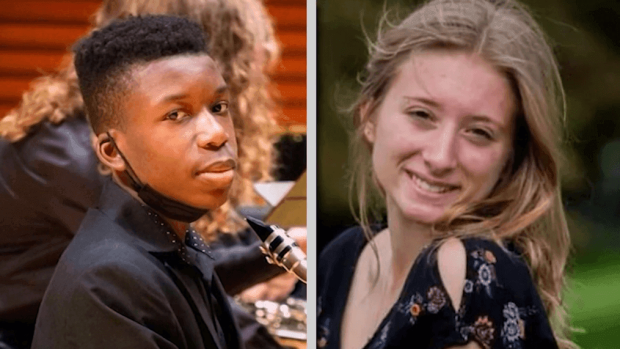Media Bias Alert: Racial Motive Hyped in Ralph Yarl Shooting Without Evidence; Kaylin Gillis Shooting Covered Less

News sources across the political spectrum highlighted the fact that Ralph Yarl, a young man who was shot in Kansas City, Missouri last week, was black and his shooter was white, even though there's no concrete evidence that race motivated the shooting.
From left to right, prominent sources displayed bias by sensationalism in their coverage, and suggested that race motivated the shooting by highlighting Yarl's race in their headlines.
Meanwhile, a very similar shooting in which a young woman was killed a few days later – with one key difference – got less prominent coverage.
/cloudfront-us-east-1.images.arcpublishing.com/gray/K45HEPP25NBETPNDGIBPKJUFKI.jpg)
On April 13, 84-year-old Andrew Lester shot 16-year-old Ralph Yarl in the head after Yarl arrived at his front door in Kansas City, Missouri, around 10:30 p.m. Yarl was reportedly at the wrong house; he intended to pick his siblings up at a different house nearby.
Yarl was released from the hospital Monday. Lester has been charged with first-degree assault and armed criminal action, and is currently out on bond.
The shooting quickly made top headlines from news sources across the political spectrum, and many featured social media posts about the story and breaking news alerts on their websites.
From left to right, news sources also emphasized in headlines and prominently in articles the fact that Yarl is black and Lester is white, even though there’s no evidence yet that the shooting was racially-motivated.
Associated Press (Lean Left bias)
![]()
![]()

Washington Examiner (Lean Right)


Major media outlets have seemingly arrived at a consensus on the shooting — that race played a role, or that the concern of a racial element in the case is cause enough to make it a central element of their coverage.
But what are the facts at this point when it comes to possible racial motivations?
The county’s prosecuting attorney said “there was a racial component to this case,” but didn't elaborate.
Three days after the shooting, Kansas City Police Chief Stacey Graves said “the information that we have now, it does not say that it's racially motivated, that's still an active investigation, but as a chief of police I do recognize the racial components of this case.”
For the record, Lester’s side of the story doesn’t mention a racial angle. Per CNN:
“According to a probable cause statement, Lester told investigators he was “scared to death” by Yarl’s size and his inability to defend himself at age 84. He told investigators he was in bed when he heard his doorbell ring and grabbed a handgun before answering the door.
He stated he believed someone was attempting to break into the house, and shot twice (through an exterior storm door) within a few seconds of opening the (main) door,” a police detective writes in the court document.”
After the shooting, Lester repeatedly expressed concern for Ralph, according to the statement.”
Ben Crump, an attorney in prominent cases of violence against black people like the murder of George Floyd, is working with Yarl's family, and questioned why Lester wasn’t immediately arrested. “Nobody can tell us if the roles were reversed, and you had a Black man shoot a White, 16-year-old teenager for merely ringing his doorbell that he would not be arrested," said Crump.
Based on your own beliefs, you may think it’s fair to suspect that at the very least, implicit racial bias played a role in the shooting. (The writer of this article, personally, would agree with you). Considering the history of race relations in the U.S., stories about racially-motivated violence are arguably more notable and should be known more widely than random acts of violence.
But without hard evidence, is it wise for media outlets to highlight the potential racial angle so strongly? It's perfectly fair for you to assume a racial angle, but "assuming" is not in a journalist's job description.
If it was just left-rated sources doing this, we might chalk this up to cultural biases. But this happened across the media spectrum. Journalists from left to right decided that a focus on the racial elements was fair.
Is that justified? Or is the media just biased in favor of clicks and sensational subjects like racial violence?

Two days after Yarl was shot in Missouri, a similar shooting happened in New York that initially got far less coverage.
Twenty-year-old Kaylin Gillis was shot dead Saturday in her car after mistakenly pulling the vehicle into the wrong driveway in upstate New York. The shooter, 65-year-old Kevin Monahan, reportedly fired two shots from his porch, and was charged with murder. Both he and Gillis are white.
Gillis’s death got some coverage across the spectrum several days later, with NPR and ABC News (both Lean Left) both featuring it prominently on their homepages at one point this week. Meanwhile, sources on all sides have covered Yarl’s story prominently for several days, and will likely continue to cover it as the investigation progresses. Some sources, like CBS Austin (Not Rated), covered the shootings together in the context of "stand-your-ground" laws.
At the time of this writing, Google returned roughly 140,000 results for “news” articles about Yarl. It returned about 15,000 for Gillis.
It’s worth looking into whether race played a role in the Yarl shooting. But it seems the media has already decided that it did, and want you to have that conclusion, too.
Not only do news sources spin stories to fit their political agendas, they also employ types of bias like slant and sensationalism as business strategies, using emotionalism to get you to click. These practices can set you up to draw misinformed conclusions.
By emphasizing Ralph Yarl’s race without concrete evidence of a racial motive, news sources primed you to see the situation as racially-charged — whether it was or not. That only works to polarize people further.
Whether you think the media's emphasis on race is fair may depend on your bias. But news sources should focus more on giving you all the facts of the case — what Yarl’s family and lawyers said, what prosecutors said, what police said, what the defendant said – to empower you to make up your own mind.
Journalists know that many people only read headlines and will share links just based on an article’s title. But the potential misleading effects of clickbait always need to be weighed against the business benefits.
Whether the shooting of Yarl was racially motivated is under investigation, and we may never know for sure. If it turns out it was, the media assumption was right. Otherwise, news reporters could do more harm than good by emphasizing racial undertones that may or may not actually have been at play.
Use our Types of Media Bias guide to stay aware of the many different ways biased media can misinform you.
Henry A. Brechter is the Editor-in-chief of AllSides. He has a Center bias.
This piece was reviewed by AllSides News Curator Andy Gorel (Center bias), AllSides Daily News Editor Joseph Ratliff (Lean Left bias), and Research and Content Intern Johnathon Held (Lean Right Bias).

May 21st, 2024


May 16th, 2024

May 16th, 2024